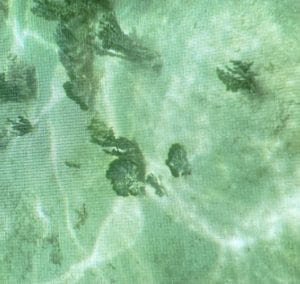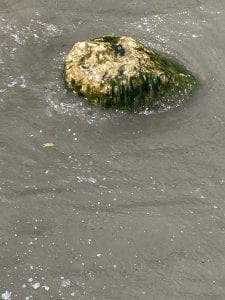Today we practiced using quadrants (squares grids for making observations) and super long tape measures called transects. We did a project in the sea grass about the density of one of my very own green algae: the genus Penicillus! These basically look like lollipops with tops made of super thin calcified filaments on top of a central stalk. We studied how the density of these algae changed as we moved farther from shore, finding density peaked 80m from the dock.
We also visited a coral graveyard. Where everything on the “beach” was petrified into stone! (including conch shells and palm tree remains). This meant that we could see incredibly pristine coral structures that underly the live polyps, and Dr. Correa was filled with overwhelming joy helping us distinguish the different species and explaining their characteristics.
Now, onto green algae. The sea grapes (Caulerpa Racemosa) I saw yesterday I am pretty sure were of the peltata variant based on the shape of the disc like cups. However, I found on the edge of a reef flat in a pretty sandy and sunny area, which makes me think I may have the wrong ID as the peltata variant is supposed to found in shade. 
Today I also found Udotea Flabellum in sandy shallow areas between sea grass. It had the distinctive sea fan shape and was in a pretty large group in close proximity to one another. 
Also, our Penicillus project brought us to lots of penicillus. The species my group found I believe to be either Penicillus capitates and Penicillus lamourrouxii based on the almost spherical cap shape. They also tended to be around one another and among the sea grass, though preferring areas of less seagrass density.
Finally, I think I saw green feather algae, Caulderpa sertulariodes on one of the posts of the dock, but I want to get a closer look tomorrow to be more sure of my ID!



